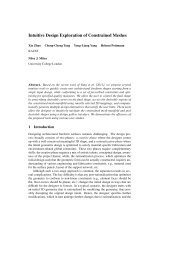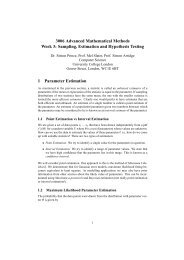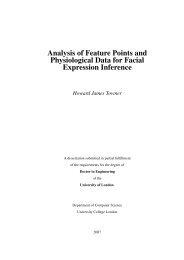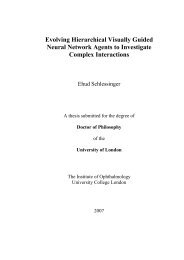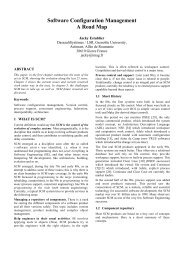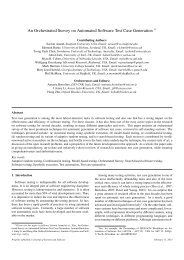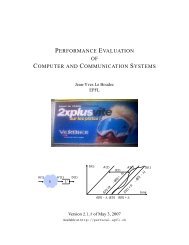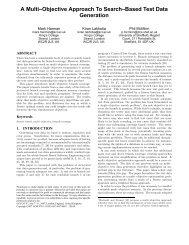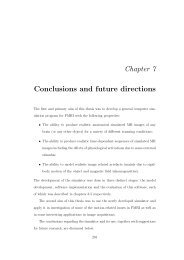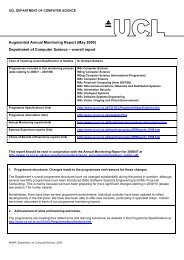Modelling and Interpretation of Architecture from Several Images
Modelling and Interpretation of Architecture from Several Images
Modelling and Interpretation of Architecture from Several Images
Create successful ePaper yourself
Turn your PDF publications into a flip-book with our unique Google optimized e-Paper software.
GoBack
<strong>Modelling</strong> <strong>and</strong> <strong>Interpretation</strong> <strong>of</strong> <strong>Architecture</strong> <strong>from</strong><strong>Several</strong> <strong>Images</strong>A.R. DICK P.H.S. TORR R. CIPOLLAPaper published: 20041 / 35
⊲ OverviewProblem StatementAlgorithm OverviewThe ArchitecturalModelParametersFormal ProblemFormulationPrior EvaluationrjMCMCOverviewModel AcquisitionAlgorithmResults2 / 35
Problem StatementOverview⊲ ProblemStatementAlgorithm OverviewThe ArchitecturalModelParametersFormal ProblemFormulationPrior EvaluationrjMCMCModel AcquisitionAlgorithmResults3 / 35
Algorithm OverviewOverviewProblem Statement⊲ AlgorithmOverviewThe ArchitecturalModelParametersFormal ProblemFormulationPrior EvaluationrjMCMCModel AcquisitionAlgorithm1. Calculate structure <strong>from</strong> motion (SFM) <strong>from</strong> the imagesequence.2. Initial estimation <strong>of</strong> wall planes.(a)Iterative refinement <strong>of</strong> wall planes (rjMCMC).3. Initial estimation <strong>of</strong> primitives on wall.(a)Iterative refinement <strong>of</strong> primitives on wall(rjMCMC).Results4 / 35
The Architectural ModelOverviewProblem StatementAlgorithm OverviewThe ArchitecturalModel⊲ParametersFormal ProblemFormulationPrior EvaluationrjMCMCModel AcquisitionAlgorithmResults□□Each wall is modelled as a rectangle <strong>and</strong> contains a set<strong>of</strong> volumetric primitives.An architectural model M contains parameters:θ = {n W ,θ W ,θ P ,θ G }, where:n Wθ Pθ Wis the number <strong>of</strong> walls in the model.is the position, orientation <strong>and</strong> boundary <strong>of</strong> thewalls.the parameters for each wall <strong>and</strong> θ G the globalparameters that apply to the entire model, i.e.Gothic, Roman, . . .5 / 35
Overview⊲ ParametersWall PlaneVolumetric ShapePrimitivesGlobal ModelParametersFormal ProblemFormulationPrior EvaluationrjMCMCParametersModel AcquisitionAlgorithmResults6 / 35
Wall PlaneOverviewParameters⊲ Wall PlaneVolumetric ShapePrimitivesGlobal ModelParametersFormal ProblemFormulationPrior EvaluationrjMCMCModel AcquisitionAlgorithmResultsEach wall plane has a width, height, normal direction <strong>and</strong>position: θ i P = wi P ,hi P ,ni ,p i Each wall parameter is furthersubdivided into: θ i W = n P,θ i L ,θi S ,θi T , where:n P is the number <strong>of</strong> volumetric primitives on the wall.θL i is an identifier for each primitive on the wall, see slide 8.θS i is the shape parameters for each primitive, see slide 8.θTi is the texture parameter for the wall. It is a value in therange (0 255) for each point g on a regular 2D gridcovering the model surface belonging to the wall (notprimitives).7 / 35
Volumetric Shape PrimitivesOverviewParametersWall Plane⊲ VolumetricShape PrimitivesGlobal ModelParametersFormal ProblemFormulationPrior EvaluationrjMCMCModel AcquisitionAlgorithmResults8 / 35
Global Model ParametersOverviewParametersWall PlaneVolumetric ShapePrimitivesGlobal ModelParameters⊲Formal ProblemFormulationThe global model parameter has prior information aboutshape, texture <strong>and</strong> kind <strong>of</strong> objects composing a building:Prior EvaluationrjMCMCModel AcquisitionAlgorithmResults9 / 35
OverviewParameters⊲Formal ProblemFormulationPosterior - 1Posterior - 2Fully exp<strong>and</strong>edposteriorPrior EvaluationrjMCMCModel AcquisitionAlgorithmFormal Problem FormulationResults10 / 35
Posterior - 1OverviewParametersFormal ProblemFormulation⊲ Posterior - 1Posterior - 2Fully exp<strong>and</strong>edposteriorPrior EvaluationrjMCMCModel AcquisitionAlgorithmResultsWe want to maximise the posterior probability <strong>of</strong> the model<strong>and</strong> parameters, given our data <strong>and</strong> prior information:P(Mθ|DI), which can be rearranged using Bayes rule <strong>and</strong>decomposed via repeated product rule:P(Mθ|DI) ∝ P(D|MθI)P(MθI)=P(D|MθI)P(θ|MI))P(MI)=P(D|MθI)P(θ G θ P θ G |MI))P(MI)=P(D|MθI)P(θ W |θ P θ G MI)P(θ P θ G |MI)P(MI)=P(D|MθI)P(θ W |θ P θ G MI)P(θ P |θ G MI)P(θ G |MI)P(MI)11 / 35
Posterior - 2OverviewParametersFormal ProblemFormulationPosterior - 1⊲ Posterior - 2Fully exp<strong>and</strong>edposteriorPrior EvaluationrjMCMCModel AcquisitionAlgorithmResultsIt is assumed that all the parameters for the primitives areindependent <strong>of</strong> each other (BAD ASSUMPTION), thus:P(θ W |θ i P θ GMI) =n W∏i=1P(θ i W |θ i Pθ G MI) The wall parametercan be decomposed into its sub-parameters:P(θW i |θi P θ GMI) = P(θL i θi S θi T |θi P θ GMI)=P(θT i |θLθ i Pθ i G MI)P(θS|θ i Lθ i Pθ i G MI)P(θL|θ i Pθ i G MI)12 / 35
Fully exp<strong>and</strong>ed posteriorOverviewParametersFormal ProblemFormulationPosterior - 1Posterior - 2Fully exp<strong>and</strong>edposterior⊲Prior EvaluationrjMCMCModel AcquisitionAlgorithmResultsThe probability for the texture <strong>of</strong> the wall <strong>and</strong> the shape <strong>of</strong>its primitives are independent to each other, thus theequation for the fully exp<strong>and</strong>ed posterior is:P(Mθ|DI) ∝ [P(D|MθI)P(θ P |θ G MI)[ nW∏P(θT i |θLθ i Pθ i G MI)] P(θT i |θLθ i Pθ i G MI)i=1]P(θ i S |θi L θi P θ GMI)P(θ i L |θi P θ GMI)Each <strong>of</strong> the factors has an interpretation, see paper.13 / 35
OverviewParametersFormal ProblemFormulation⊲ Prior EvaluationLikelihoodEvaluationWall Plane PriorEvaluationShape PriorEvaluationTexture PriorEvaluationPrior EvaluationrjMCMCModel AcquisitionAlgorithmResults14 / 35
Likelihood EvaluationOverviewParametersFormal ProblemFormulationPrior Evaluation⊲ LikelihoodEvaluationWall Plane PriorEvaluationShape PriorEvaluationTexture PriorEvaluationrjMCMCModel AcquisitionAlgorithmResultsThe likelihood <strong>of</strong> the data given the Model (M), theparameters (θ) <strong>and</strong> the prior information (I) is evaluated as:P(D|MθI) = ∏ ∏ 1√ exp − 1 ( ) i(g j 2) − i(g),2πσǫ 2 σg jǫwhere i(g j ) is the intensity <strong>of</strong> the gth pixel (sampled atregular intervals) in the jth image.Surfaces are assumed to be Lambertian (colour <strong>and</strong> intensityemission independent <strong>of</strong> viewing angle), to make up for thisthe distribution U(0, 255) multiplied by a mixing constant λis added: P(D|MθI) = λ ∗ P(D|MθI) + (1 − λ) 125615 / 35
Wall Plane Prior EvaluationOverviewParametersFormal ProblemFormulationPrior EvaluationLikelihoodEvaluation⊲Wall Plane PriorEvaluationShape PriorEvaluationTexture PriorEvaluationrjMCMCModel AcquisitionAlgorithmResultsThe wall plane prior is based on the architectural heuristicsthat neighbouring walls intersect at right angles, they areperpendicular to the ground plane <strong>and</strong> the height-width ratio<strong>of</strong> walls is constraint. The terms composing the prior areindependent <strong>of</strong> each other:P(θ P |θ G MI) = P(n|θ G MI)P(p|θ G MI)P({h p ,w P }|θ G MI)Each <strong>of</strong> these terms is represented by a simple distribution:∑n−1( ) 2 φI − π/2P(n|θ G MI)α, where φ i is the interiori=1σ φangle between planes i <strong>and</strong> i + 1.P({h p ,w p }|θ G MI) = 1, if 0.25 ≤ h P /w P ≤ 4= 0, otherwiseThe distribution <strong>of</strong> the walls position is uniform.16 / 35
Shape Prior EvaluationOverviewParametersFormal ProblemFormulationPrior EvaluationLikelihoodEvaluationWall Plane PriorEvaluation⊲Shape PriorEvaluationTexture PriorEvaluationrjMCMCModel AcquisitionAlgorithmResultsThe architectural shape prior for primitives,P(θ S |θ L θ P θ G MI), is defined <strong>and</strong> assessed using a MarkovChain simulation. This prior encodes information about:□□□□The scale <strong>of</strong> each primitive (if absolute scale is known).The shape <strong>of</strong> each primitive.The alignment <strong>of</strong> primitives.Other spatial relations, such as symmetry about avertical axis.As it is not feasible to draw samples <strong>from</strong> this distributiondirectly MCMC has to be used. They use Reversible JumpMarkov Chain Monte Carlo sampling, because <strong>of</strong> the varyingdimension <strong>of</strong> the parameter space.17 / 35
Texture Prior EvaluationOverviewParametersFormal ProblemFormulationPrior EvaluationLikelihoodEvaluationWall Plane PriorEvaluationShape PriorEvaluationTexture PriorEvaluation⊲rjMCMCModel AcquisitionAlgorithmThe texture prior, P(θ T |θ L θ P θ G MI), is learnt <strong>from</strong> a settraining <strong>of</strong> images. To reduce the impacts such as lightning<strong>and</strong> scale <strong>of</strong> the textures, a wavelet decomposition is appliedto the images. The output <strong>of</strong> that decomposition gives 4transformed images: HH, HL, LL <strong>and</strong> HH, where the firstletter st<strong>and</strong>s for the horizontal direction <strong>and</strong> the second forthe vertical direction; H indicates the high-pass <strong>and</strong> L thelow-pass filter, respectively. These outputs are quantised <strong>and</strong>put into bins.Results18 / 35
OverviewParametersFormal ProblemFormulationPrior Evaluation⊲ rjMCMCScoring functionJumpingDistributionList <strong>of</strong> JumpsModel AcquisitionAlgorithmrjMCMCResults19 / 35
Scoring functionOverviewParametersFormal ProblemFormulationPrior EvaluationrjMCMC⊲ Scoring functionJumpingDistributionList <strong>of</strong> JumpsModel AcquisitionAlgorithmResultsThe scoring function is used to evaluate the shape prior bycombining its individual terms:f prior (θ) = f scale (θ) + f shape (θ) + f align (θ)f sym (θ) The shape<strong>and</strong> scale terms are used to disqualify implausible primitives. Thealignment <strong>and</strong> symmetry terms are evaluated as:R∑f align (θ) = [V ar(t r ) + V ar(b r ) + V ar(r r − l r )] +r=1C∑[V ar(l c ) + V ar(r c ) + V ar(t c − b c )], where t r , b r , l r , r r <strong>and</strong>c=1t c , b c , l c , r c are the top, bottom, left <strong>and</strong> right coordinatesbelonging to a row <strong>and</strong> column <strong>of</strong> shapes, respectively.R∑f sym (θ) = [(l r − l) − (r r − r)] 2 , where l r <strong>and</strong> r r are ther=1leftmost <strong>and</strong> rightmost point <strong>of</strong> row r, respectively. NB:Symmetry only defined for columns.20 / 35
Jumping DistributionOverviewParametersFormal ProblemFormulationPrior EvaluationrjMCMCScoring function⊲ JumpingDistributionList <strong>of</strong> JumpsModel AcquisitionAlgorithmrjMCMC requires a jumping distribution J t (θ t |θ t−1 ). Therequirements for this distribution are:□□□When adding/removing walls, the building should stillremain closed.Should be easy to sample, with high acceptance, i.e.jumps increase probability <strong>of</strong> model.Jumps must be reversible.Results21 / 35
List <strong>of</strong> JumpsOverviewParametersFormal ProblemFormulationPrior EvaluationrjMCMCScoring functionJumpingDistribution⊲ List <strong>of</strong> JumpsModel AcquisitionAlgorithmResults22 / 35
OverviewParametersFormal ProblemFormulationPrior EvaluationrjMCMCModelAcquisition⊲ AlgorithmDetailed AlgorithmOverviewWall PlanesOptimising WallPlanesPrimitivesPrimitive LikelihoodsPrimitive parameterrefinementMAP ModelModel Acquisition AlgorithmResults23 / 35
Detailed Algorithm OverviewOverviewParametersFormal ProblemFormulationFull algorithm for obtaining the MAP solution:Prior EvaluationrjMCMCModel AcquisitionAlgorithmDetailedAlgorithm⊲ OverviewWall PlanesOptimising WallPlanesPrimitivesPrimitive LikelihoodsPrimitive parameterrefinementMAP ModelResults24 / 35
Wall PlanesOverviewParametersFormal ProblemFormulationPrior EvaluationrjMCMCModel AcquisitionAlgorithmDetailed AlgorithmOverview⊲ Wall PlanesOptimising WallPlanesPrimitivesPrimitive LikelihoodsPrimitive parameterrefinementMAP ModelFrom the point cloud obtained <strong>from</strong> the SFM, the wallplanes need to be estimated. First the the dominant planesare extracted using a RANSAC technique, where the twomost commonly occurring orientations <strong>of</strong> lines are belongingto each plane are taken as the horizontal <strong>and</strong> vertical axis <strong>of</strong>the plane. Next the sides <strong>of</strong> the wall are aligned with thesedirections. The dimensions <strong>of</strong> the wall is the minimum span<strong>of</strong> all points <strong>from</strong> that plane. The inliers for that plane areremoved form the point cloud <strong>and</strong> the same technique isrepeated, to find subsequent wall planes.Results25 / 35
Optimising Wall PlanesOverviewParametersFormal ProblemFormulationPrior EvaluationThe two main error in the initial wall plane estimation arethe ground plane normal <strong>and</strong> the bounding rectangle, so themodel is optimized using gradient descent.rjMCMCModel AcquisitionAlgorithmDetailed AlgorithmOverviewWall PlanesOptimising Wall⊲ PlanesPrimitivesPrimitive LikelihoodsPrimitive parameterrefinementMAP ModelResultsPlot in middle error surface is flat, because sky <strong>and</strong> groundare featureless.26 / 35
PrimitivesOverviewParametersFormal ProblemFormulationPrior EvaluationrjMCMCModel AcquisitionAlgorithmDetailed AlgorithmOverviewWall PlanesOptimising WallPlanes⊲ PrimitivesPrimitive LikelihoodsPrimitive parameterrefinementMAP ModelResultsParameters θ S 1 are sampled at regular intervals for eachprimitive θ L . The likelihood is evaluated <strong>from</strong> the singlemost frontal image D 1 as:P(D 1 |θ T 1θ S 1θ L MI) =n W∏i=0∏x∈θ i T∏kf θi Lk (W k(x)), whereW k (X) denotes a 3x3 patch <strong>of</strong> subb<strong>and</strong> k <strong>of</strong> the waveletdecomposition centred at x. f θi Lkdenotes frequency in thenormalised histogram for primitive type θL i <strong>of</strong> subb<strong>and</strong> k.□Texture histograms are learnt for different subtypes <strong>of</strong>primitives (window patterns)27 / 35
Primitive LikelihoodsOverviewParametersFormal ProblemFormulationCollection <strong>of</strong> shape primitives <strong>and</strong> their likelihoods.Prior EvaluationrjMCMCModel AcquisitionAlgorithmDetailed AlgorithmOverviewWall PlanesOptimising WallPlanesPrimitives⊲ PrimitiveLikelihoodsPrimitive parameterrefinementMAP ModelResults28 / 35
Primitive parameter refinementOverviewParametersFormal ProblemFormulationPrior EvaluationrjMCMCModel AcquisitionAlgorithmDetailed AlgorithmOverviewWall PlanesOptimising WallPlanesPrimitivesPrimitive LikelihoodsPrimitiveparameter⊲ refinementMAP ModelResults□□□□After the parameters {x,y,w,h} <strong>from</strong> the single viewhave been initialised, <strong>from</strong> multiple views the parametersthe remaining parameters for the primitives {d,a,b,dw}are estimated.Occam Factor is used to penalize model complexity <strong>and</strong>keep the models as simple as possible, to avoidoverfitting.To evaluate whether a primitive should be kept in themodel, its full likelihood ration against the model withno primitives is compared: L i M = P(D|θi MI)P(D|θ 0 M 0 IThe maximum likelihood model would include allnon-overlapping shapes with ratio < 1.29 / 35
MAP ModelOverviewParametersFormal ProblemFormulationPrior EvaluationrjMCMCModel AcquisitionAlgorithmDetailed AlgorithmOverviewWall PlanesOptimising WallPlanesPrimitivesPrimitive LikelihoodsPrimitive parameterrefinement⊲ MAP ModelResultsThe complete scoring function, including the imageinformation, is given by:□ f(θ) = λf prior (θ + ∑ m∑( ) i(g j 2) − i(g))σi(g) j=1□ Seed points <strong>from</strong> previous MAP estimations, with anacceptance threshold <strong>of</strong> a fixed range <strong>of</strong> primitives permodel.30 / 35
OverviewParametersFormal ProblemFormulationPrior EvaluationrjMCMCModel AcquisitionAlgorithm⊲ ResultsComparison toground truthDowning LibraryAmbiguitiesNotesResults31 / 35
Comparison to ground truthOverviewParametersFormal ProblemFormulationPrior EvaluationrjMCMCModel AcquisitionAlgorithmResultsComparison to⊲ ground truthDowning LibraryAmbiguitiesNotes32 / 35
Downing LibraryOverviewParametersFormal ProblemFormulationPrior EvaluationrjMCMCModel AcquisitionAlgorithmResultsComparison toground truth⊲ Downing LibraryAmbiguitiesNotes33 / 35
AmbiguitiesOverviewParametersFormal ProblemFormulationPrior EvaluationrjMCMCModel AcquisitionAlgorithmResultsComparison toground truthDowning Library⊲ AmbiguitiesNotes34 / 35
NotesOverviewParametersFormal ProblemFormulationPrior EvaluationrjMCMCModel AcquisitionAlgorithmResultsComparison toground truthDowning LibraryAmbiguities⊲ Notes□□Model choice (prior) is not that important forreconstruction.Initial wall planes estimates need to be accurate,otherwise primitive detection becomes unreliable.35 / 35



